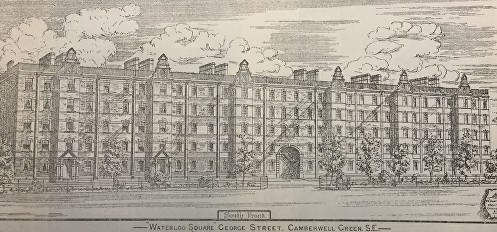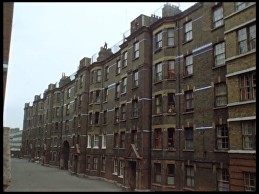





Exploring Southwark and discovering its history


Waterloo Square, Camberwell
Waterloo Square near Camberwell Green was a late Victorian development that comprised 13 tenement blocks providing what was described as improved housing for the industrial classes. It was located at the bottom of George Street, now called Lomond Street, and today the site of the Peabody Lomond Grove estate. The tenement blocks were built by the National Dwellings Society Limited, one of the organisations who combined philanthropy by providing decent housing at low cost to working men with a modest return to investors. The Society was founded in 1875 with the aim of not only building new estates but also repairing and refurbishing existing smaller properties.
By 1887, they had built several estates including ones in Lewisham, Blackheath and the East End. They launched a prospectus to raise money by offering preferential shares with a 5% return for the new development in Camberwell which was described as containing “nearly 600 habitable rooms suitable for the homes of the poorer working classes. They will be divided into letting of one two and three rooms each, and will be let at from 2/6 for a single room, up to about 7s for the best three room lettings.
“The greatest possible care has been taken in the arrangement of the plans of these buildings and the latest improvements in ventilation and sanitation have been adopted and it is believed that these buildings in arrangement and construction will be equal if not superior to any houses of a similar character erected in London.
“The houses forming Waterloo Square will consist of thirteen blocks of buildings – six blocks being on one side of the Square and seven blocks on the opposite side. The distance between the respective blocks of buildings will be about 60 feet and in the centre of the roadway between the buildings it is proposed to plant a number of trees and shrubs the full length of the buildings with a drinking fountain. The roads are to be asphalted for the purpose of cleanliness and every convenience will be provided for the comfort of the tenants.
“The houses will be substantially built and separate entrances will be provided to every tenement whether consisting of one or more rooms. The staircases and landings will be wide and well constructed and thoroughly ventilated. The closets, sinks and all pipes connected with the drainage will be contained in the outbuildings and these buildings will be entered from each landing, thereby preventing the possibility of any obnoxious gases being discharged into that part of the building occupied by the tenants. The tops of the buildings will be utilised as wash-houses, drying grounds etc.
“The elevation and ornamentation of the buildings will be carefully attended to and be made as attractive as possible having regard of course to expense, it being the desire of the Council of the Society rather to have good useful and suitable dwellings than to have them in any way over-decorated.”
(From ‘Philanthropy and five per cent’, The National Dwellings Society Limited, 1887)


But though the last block built was described as one of the finest of its kind upon completion, what had been considered “improved” housing at the end of the 19th century was considered sub-standard in the 1960s. The entrance halls were dark and some apartments were so dark a light had to be left on all day. Not all the flats had running water and the toilets and sinks were each shared by two or three families. The wash-houses and toilets had no lighting and
there was no sign of the shrubs or trees described in the prospectus. Compared with the bright new flats that were being erected by the council as part of the post-war reconstruction, the Victorian blocks were ugly, gloomy and foreboding.
The National Dwellings Society Ltd was wound up in 1952 and at some stage the site was acquired by the Council. This may have been a result of a compulsory purchase order in line with the slum clearance and bomb damage programme being undertaken by Camberwell Borough Council and later Southwark Council at that time but so far I have been unable to confirm this. The site was acquired leasehold by the Peabody Trust in 1976 with Southwark Council retaining the freehold where Peabody built the low rise Lomond Grove estate, a mix of general and sheltered housing.
Web discoveries
- UK Casino Not On Gamstop
- UK Casino Not On Gamstop
- Non Gamstop Casino
- Casinos Not On Gamstop
- Non Gamstop Casinos
- Non Gamstop Casinos
- Non Gamstop Casino
- Casino Sites Not On Gamstop
- Slots Not On Gamstop
- Casinos Not On Gamstop
- UK Betting Sites Not On Gamstop
- UK Casino Not On Gamstop
- Best Non Gamstop Casinos
- Betting Sites
- Non Gamstop Casino Sites UK
- Best Non Gamstop Casinos
- Non Gamstop Casino
- Casinos Not On Gamstop
- Non Gamstop Casino Sites UK